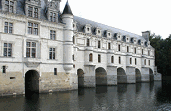|
Then after the French Revolution Napoleon commissioned the
architect Berthault to restore the castle, which is where he welcomed his second wife,
Archduchess Marie-Louise of Austria, in 1810.
It was during the Second Empire that the Chateau
de Compiegne once again became a place of royal ceremony and Napoleon III with
Eugénie made Compiegne their autumn residence holding weekend parties for the political,
artistic and scientific elite to attend.
The Chateau of Compiegne occupies a special place in the history of the Second Empire and
after the fall of the Imperial Regime in 1870, the Chateau de Compiegne became a national
museum.
Napoleon III and the Empress Eugenie left a permanent reminder of their frequent visits to
the castle and it was therefore obvious to establish a museum of the Second Empire in a
place where objects and works have remained since 1870.
It was in the year 1953 that the Museum of the Second Empire took on a considerable
extension with works that were previously kept at the National Museum of the Chateau de
Malmaison, along with collections for Prince Napoleon that were added in 1968. There
have also been lots of other additions at separate times as well, which have really
enhanced and enriched the museum collection.
Housed in the old dignitaries' apartments, the Musee du Second Empire brings together
works by some great sculptors of the second half of the 19th century such as Jean-Auguste
Barre, Albert-Ernest Carrier-Belleuse, Jean-Baptiste Carpeaux and Emmanuel Frémiet.
Plus there is the portrait of the young Prince Imperial, which is one of the most famous
works produced by Jean-Baptiste Carpeaux and this just emphasises the quality of this
remarkable collection.
This museum has a unique portrait gallery of paintings and drawings that show the
splendour of the Imperial Court such as the famous painting of the Empress Eugénie with
her maids of honour by the artist Winterhalter.
But as well as these you will be able to see furniture, jewellery, objet d'art, dishes,
bronzes, clocks, silverware, etc that show the tastes and sophisticated lifestyle of the
imperial family and the Court.
Also inside the castle, you will be able to experience the historical apartments and the
halls of the First Empire such as the bedroom and library of the Emperor, the Salon des
Fleurs, which was actually a games room where you can see items like a backgammon table
and the Galerie de Bal, or grand ballroom.
The royal Chateau of Compiegne and Le Musee du Second Empire is a great place to visit and
there is even a second museum situated here called the Musee de la Voiture et du Tourisme, which
basically translates to the Museum of the Car and Tourism.
To reach the chateau by car from Paris you would
need to take the A1 motorway and exit 9 to South Compiègne or travelling from Lille you
would need to take the same A1 motorway but exit 10 to Arsy.
An audio guide is included within the price of admission, but it is completely free for
children under the ages of 18.
The castle and museum is open every day of the week except for a Tuesday and national
holidays. The opening times for this museum are from 10am through to 6pm and last
entry is one hour before it closes.
Address & Contact Details:
Le Musee du Second Empire
Château de Compiègne
Place du Général de Gaulle
60200
Compiègne
France
Telephone: 3 44 38 47 02
|
|



